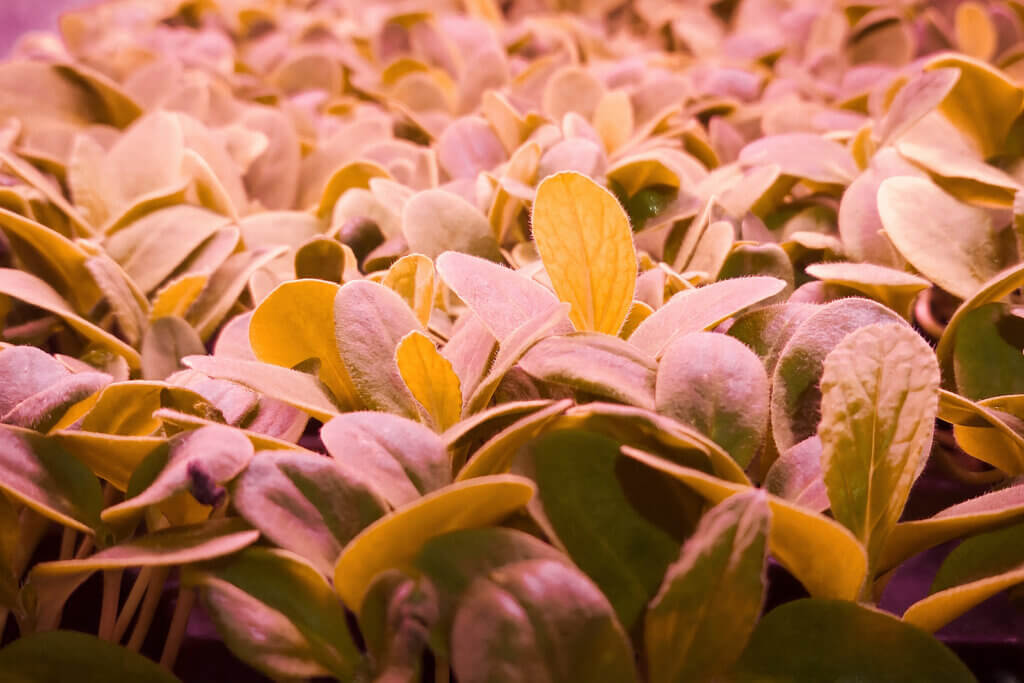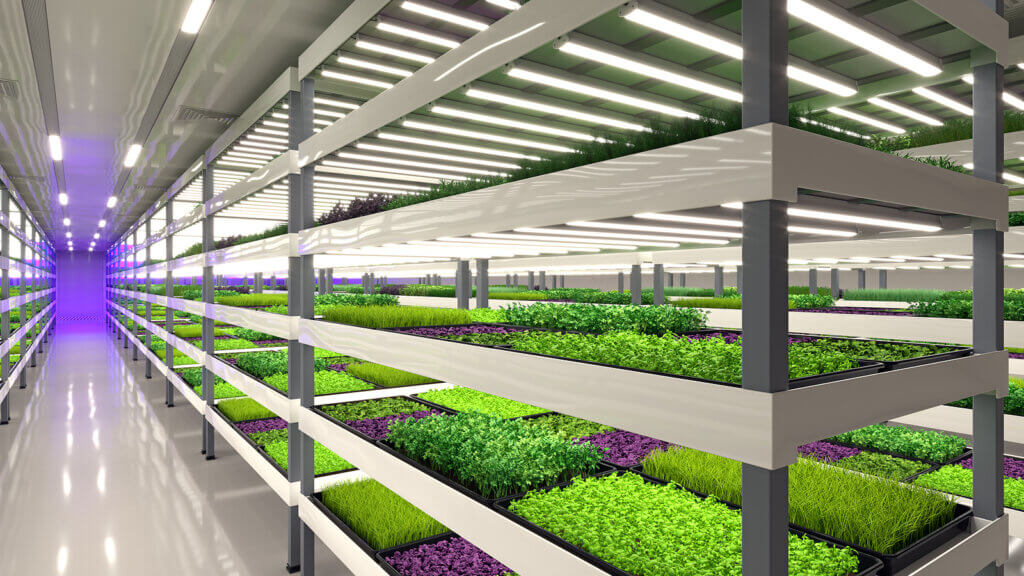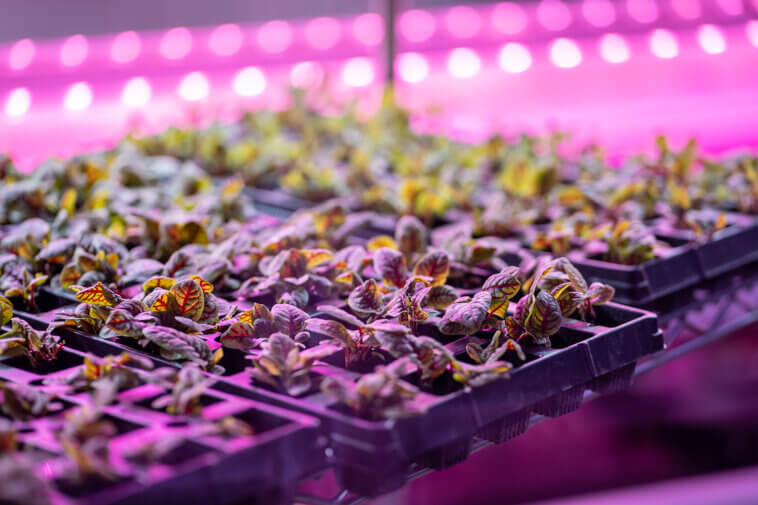Table of Contents
Microgreens have gained immense popularity among health-conscious consumers, chefs, and home gardeners for their vibrant colors, intense flavors, and impressive nutritional content. Growing microgreens at home can be a rewarding and cost-effective way to enjoy these miniature nutrient powerhouses.
To achieve the best results, however, you'll need to provide them with the right conditions, and one crucial factor in their successful growth is proper lighting. In this comprehensive guide, we will delve into the world of LED grow lights for microgreens and explore how they can help you cultivate healthy and flavorful microgreens year-round.
Why Choose LED Grow Lights for Microgreens
LED (Light Emitting Diode) grow lights have emerged as a preferred option for indoor growers, especially those cultivating microgreens. This preference is rooted in several key benefits that LED lights offer, making them superior to traditional lighting methods in various aspects:
Exceptional Energy Efficiency
LED grow lights stand out for their remarkable energy efficiency. They effectively convert a high percentage of electrical energy into usable light, directly benefiting plant growth. This efficient conversion translates to considerable savings on energy bills and contributes to a lower environmental footprint.
Precise Spectrum Control
One of the unique features of LED lights is the ability to emit specific light wavelengths. This capability allows growers to customize the light spectrum to meet the exact requirements of microgreens at different stages of growth. By tuning the spectrum, growers can enhance growth rates, improve plant health, and even influence certain characteristics like flavor and color.
Extended Lifespan and Durability
LED grow lights are known for their long service life, often exceeding 50,000 hours of operation. This durability means fewer replacements and less maintenance, reducing long-term costs and the inconvenience of frequent light changes.
Minimal Heat Emission
Unlike traditional high-intensity discharge (HID) lights, LEDs produce very little heat. This lower heat output mitigates the risk of heat stress on plants and decreases fire hazards, making the growing environment safer and more stable.
Compact and Versatile Design
The design of LED grow lights is typically compact and lightweight. This makes them easy to install and reposition, offering flexibility in arranging and optimizing the lighting setup to suit the specific needs of a microgreen growing operation.
Eco-Friendly and Safe Disposal
LED lights are free from hazardous substances like mercury, which are commonly found in some traditional lighting systems. This absence of toxic materials makes LEDs safer for the environment and easier to dispose of at the end of their lifecycle.

Understanding the Lighting Needs of Microgreens
Microgreens, the young seedlings of various vegetables and herbs, have very specific needs when it comes to lighting. Understanding and meeting these needs is crucial for their healthy growth and development. Each stage of their growth cycle demands different lighting conditions:
Initial Stage – Germination
In the germination phase, microgreens require a delicate balance of conditions, including low light intensity. During this period, their primary focus is on root and shoot development, and excessive light can be more harmful than beneficial.
Simple fluorescent lights or T5 grow lights are often sufficient for this stage, providing just enough light to support the initial growth without overwhelming the delicate seedlings.
Mid-Stage – Growth and Development
As microgreens transition from germination to more robust growth, their lighting needs increase significantly. The goal during this phase is to provide ample photosynthetically active radiation (PAR), which is critical for their growth.
This light includes specific wavelengths, particularly red and blue, which are known to significantly influence plant growth. Red light encourages stem elongation and flowering, while blue light promotes leaf growth and stronger root systems. This stage is critical as it sets the foundation for healthy, vigorous plants.
Final Stage – Color and Flavor Development
In the days leading up to harvest, microgreens benefit greatly from a full spectrum of light, including not just red and blue wavelengths, but also green and yellow. This broader spectrum plays a pivotal role in developing the microgreens' characteristic colors and flavors, making them more appealing and nutritious. This light spectrum can also influence the concentration of vitamins and antioxidants in the microgreens, enhancing their health benefits.
Considering Light Intensity and Duration
Beyond just the spectrum, the intensity and duration of light are also vital. Microgreens generally require bright light but not as intense as that needed for fully grown plants. The duration of light exposure each day (photoperiod) needs to be carefully controlled to mimic natural daylight cycles, promoting optimal growth led grow lights for microgreens.
Adapting to Specific Varieties
Different varieties of microgreens might have slightly varied requirements in terms of light intensity and spectrum. Some may thrive under a broader spectrum, while others might need a more focused range of wavelengths. Understanding these nuances can significantly impact the quality and yield of the microgreens.
See also our post on Tips for Cucumber Microgreens
Types of LED Grow Lights
Choosing the right LED grow lights for microgreens involves navigating a variety of options, each offering distinct advantages and suitability for different growing scenarios. Understanding the specifics of each type can help in selecting the ideal lighting solution for your microgreen cultivation. Let's delve into some of the common types of LED grow lights:
Full-Spectrum LED Grow Lights
These lights are engineered to mimic the comprehensive range of natural sunlight, emitting a spectrum that extends from ultraviolet (UV) to infrared (IR). The versatility of full-spectrum LED grow lights makes them apt for all growth stages of microgreens.
They provide a balanced light spectrum that not only supports basic growth processes but also significantly enhances the flavor, color, and nutritional value of microgreens. The inclusion of UV and IR wavelengths can also influence the development of beneficial compounds in the plants best lights for microgreens.
Targeted Red and Blue LED Grow Lights
This type of grow light focuses on the red and blue parts of the spectrum, which are crucial for specific plant growth functions. Red light, typically around 660-670 nanometers (nm), is essential for photosynthesis and flowering.
Blue light, in the range of 430-450 nm, primarily supports vegetative growth by promoting healthy leaf and stem development. These lights are particularly effective during the intensive growth phase of microgreens, where targeted light wavelengths can stimulate faster and healthier growth are the best lights.
Adjustable Spectrum LED Grow Lights
These lights offer the flexibility of adjusting light spectra. They are designed to cater to the varying light requirements of different growth stages. With adjustable spectrum lights, growers can fine-tune the light settings, such as increasing red light during flowering stages or enhancing blue light during vegetative growth.
This type of light is especially beneficial for growers experimenting with various microgreen species or those looking to optimize their growth environment for best results led shop lights.
Quantum Boards and COB (Chip-On-Board) LED Lights
Quantum boards and COB LED lights are known for their high light intensity and wide coverage area, making them ideal for larger scale microgreen cultivation. Quantum boards are flat panels with multiple small LED chips, offering uniform light distribution.
COB lights, on the other hand, pack multiple LED chips into a small area, creating a powerful and focused light source. Both types often include heat sinks or other cooling mechanisms to manage the heat they generate, ensuring longevity and efficiency lights for growing microgreens.
Factors to Consider When Selecting LED Grow Lights
Choosing the right LED grow lights for your microgreens involves evaluating several key factors to ensure optimal growth and yield. Let's explore these factors in detail:
- Light Intensity: Light intensity is measured in PAR (photosynthetically active radiation) or PPFD (photosynthetic photon flux density). Microgreens require different light intensities at various growth stages. For germination, a lower light intensity (100-200 µmol/m²/s) is sufficient, while the growth and development phase may require higher intensities (200-400 µmol/m²/s). Ensure that the LED grow lights you choose can deliver the appropriate light levels for your microgreens.
- Light Spectrum: As mentioned earlier, the spectrum of light is critical for microgreen growth. Look for LED grow lights that offer adjustable spectrum settings or a full spectrum to cover all growth stages. Red and blue wavelengths are essential for vegetative growth, while a broader spectrum helps with color and flavor development.
- Size and Coverage Area: Consider the size of your growing space and the number of microgreens you plan to cultivate. LED grow lights come in various sizes and coverage areas. Ensure that the lights you choose can adequately cover your growing area, providing uniform light distribution.
- Energy Efficiency: Energy-efficient LED grow lights can significantly reduce your electricity bills in the long run. Look for lights with high efficacy ratings, indicating how efficiently they convert electricity into light.
- Durability and Lifespan: Invest in LED grow lights with a long lifespan to minimize replacements. High-quality LEDs can last 50,000 hours or more. Additionally, check for a warranty to ensure your investment is protected.
- Heat Management: LED grow lights generate less heat than traditional lighting options, but heat management is still essential. Lights with built-in heat sinks or fans help dissipate excess heat, maintaining a stable environment for your microgreens.

Setting Up Your LED Grow Light System
Creating an ideal environment for microgreens requires careful setup of your LED grow light system. From positioning the lights to managing environmental conditions, every aspect plays a vital role in ensuring healthy growth. Follow these detailed steps to set up your system effectively:
Mounting the LED Grow Lights
The positioning of your LED grow lights is crucial. Mount them at a height recommended by the manufacturer, which is typically between 6 to 18 inches above the microgreens. The correct distance depends on several factors, including the intensity of the lights and the growth stage of the microgreens. For seedlings, a higher placement is often preferable to avoid overexposure, while mature plants may benefit from closer, more intense light.
Uniform Light Distribution
Ensure that your LED grow lights evenly cover the entire growing area. Consistent light distribution is key to uniform growth. Inadequately lit areas can lead to uneven growth, with some microgreens growing taller or healthier than others. Consider using reflective materials or positioning the lights strategically to achieve uniform coverage.
Light Cycle Management
Setting a timer for your LED grow lights helps maintain a consistent light cycle, which is crucial for the growth of microgreens. Most varieties thrive under 16-18 hours of light per day during their growth phase. As they mature, gradually reduce the light duration to about 12 hours a day. This mimics natural daylight patterns and supports the plants’ circadian rhythms.
Temperature and Humidity Control
Microgreens are sensitive to environmental conditions. Maintain a temperature range of 65°F to 75°F (18°C to 24°C) and humidity levels around 40% to 60% in your growing space. Deviations from these ranges can stress the plants, affecting their growth and health. Use thermometers and hygrometers to monitor these conditions and make adjustments as necessary.
Watering Practices
Proper watering is essential for microgreens. They require a consistent supply of moisture but are susceptible to overwatering. Use a gentle spray or mist to water the plants, ensuring that the delicate leaves and stems are not damaged. It’s also important to ensure good drainage in your growing setup to prevent waterlogging, which can lead to root rot and other issues.
Nutrient Management
While microgreens can grow in a nutrient-light environment, they still benefit from some fertilization. Use a diluted balanced liquid fertilizer appropriate for microgreens. Over-fertilization can harm these delicate plants, so it's important to follow the recommended dilution rates and application frequencies.
Monitoring and Adjustments
Regularly monitor the growth of your microgreens and adjust the lighting and environmental conditions as needed. Look out for signs of stress such as yellowing leaves or stunted growth, which might indicate issues with light intensity, temperature, or water levels.
Cleaning and Maintenance
Keep your growing area and equipment clean to prevent the spread of diseases and pests. Regularly clean and disinfect trays, containers, and tools. Also, ensure that your LED grow lights are free from dust and debris to maintain optimal performance.
Tips for Growing Microgreens with LED Lights
Growing microgreens under LED lights can be a rewarding experience, but it requires attention to detail and understanding of the plants' needs. Here are some advanced tips to help you maximize your success in cultivating microgreens with LED lighting:
- Selecting the Right Microgreen Varieties: Choose varieties that are well-suited for indoor cultivation under LED lights. Consider microgreens that have similar lighting and temperature requirements to simplify your growing process. Popular choices for LED light cultivation include arugula, basil, kale, radish, and mustard greens. These varieties are known for their adaptability to indoor conditions and their responsiveness to LED lighting.
- Optimizing Sowing and Germination: Proper seeding density is crucial for healthy microgreen growth. Overcrowding can lead to poor air circulation and increased disease risk, while sparse sowing may result in inefficient use of space. Ensure good seed-to-soil contact to promote uniform germination and maintain consistent moisture levels, especially in the critical germination stage. Covering the seeds lightly with a thin soil layer or a germination mat can help maintain the ideal microenvironment for sprouting.
- Ensuring Adequate Ventilation: Good air circulation is key to preventing mold and disease, which can quickly devastate a crop of microgreens. Use a small fan to circulate air in your growing area, but ensure that the airflow is not too strong as to dry out the seedlings or disturb the soil.
- Adjusting Light Distance for Optimal Growth: As your microgreens grow, they'll need different light intensities. Start with your LED lights at the manufacturer's recommended distance, but be prepared to adjust as your plants develop. Keeping the lights too close can cause burning or bleaching, while lights that are too far away may lead to leggy, stretched plants.
- Managing Light Cycles Effectively: Microgreens generally require consistent light cycles to thrive. Sudden changes in light duration can stress the plants. Start with a longer light cycle (16-18 hours) during the initial growth stages and gradually reduce it as the plants mature. Use a timer to maintain a regular light schedule.
- Controlling Temperature and Humidity: Microgreens prefer a specific range of temperatures and humidity levels. Generally, a temperature range of 65°F to 75°F (18°C to 24°C) and humidity between 40% and 60% is ideal. Use a thermometer and hygrometer to monitor these conditions and adjust your environment accordingly.
- Fertilizing for Healthy Growth: Once your microgreens develop their first true leaves, they can benefit from a light application of fertilizer. Use a balanced liquid fertilizer at half the strength recommended for mature plants. Over-fertilization can lead to excessive growth at the expense of flavor and texture.
- Harvesting for Peak Flavor and Nutrition: Harvest your microgreens when they're at the desired size, which is typically 7-21 days after sowing, depending on the variety. Use clean, sharp scissors or a knife to cut the microgreens just above the soil surface. Harvest in the morning when the plants are most turgid for the best texture and flavor. Rinse your microgreens gently and enjoy them fresh for maximum nutritional benefits.
Conclusion
Embarking on the journey of growing microgreens at home using LED grow lights is more than just a hobby; it's a step towards a sustainable, healthy lifestyle. This process is not only enriching in terms of learning about the intricacies of plant growth but also rewarding as you witness these tiny greens flourish under your care.
The use of LED lights, known for their energy efficiency and effectiveness, adds a touch of modernity to this nature-centric endeavor, creating a harmonious blend of technology and gardening.
As a personal endeavor, growing microgreens becomes a reflection of a commitment to wellness, self-sufficiency, and environmental consciousness. It's a delightful and fulfilling experience to cultivate and harvest your own nutrient-rich food, understanding the effort and care that goes into every leaf.
This practice is more than just about the end product; it's about embracing a lifestyle that values the simplicity of nature, the joy of gardening, and the satisfaction of consuming what you've carefully grown. Whether you're a novice or an experienced gardener, the world of microgreens is an inviting space, full of possibilities and discoveries waiting to be made.
Sources
https://www.ncbi.nlm.nih.gov/pmc/articles/PMC8781578/
https://microgreensworld.com/comprehensive-guide-to-microgreens-lighting-requirements/
https://veg.mafes.msstate.edu/content/led-light-intensity-microgreens




Comments
Loading…